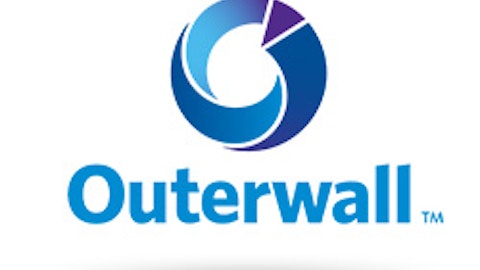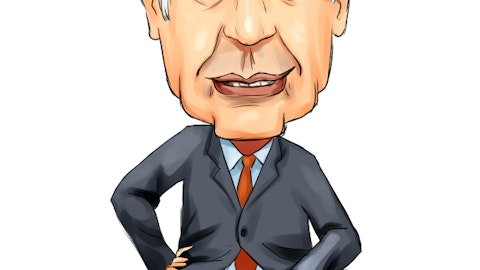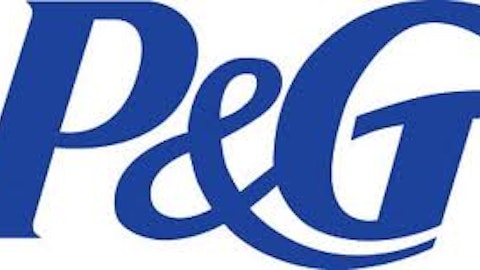The Dow Jones Industrial Average (INDEXDJX:.

Source: Wal-Mart, Flickr.
According to a study conducted on a regular basis by Gallup, known as the Gallup-Healthways Well-Being Index, consumers right now are having more trouble affording life’s necessities than at almost any other time in the past five years. In particular, one question asked of the approximately 15,729 respondents is whether they’ve struggled to provide food for their family at any time over the past 12 months. A surprising 20% of respondents in August noted that they’d struggled to put food on the table for their families, matching the highest mark achieved in 2011 and coming very close to eclipsing the all-time peak of 20.4% in November 2008.
You might be thinking to yourself, “OK, so food prices have gone up and a few more people than before are struggling to purchase food.” The problem with that assumption is that food costs really haven’t gone up. In fact, food inflation is about as stable as I can ever recall it, meaning there are other factors at work here beyond just inflation.
The Gallup-Healthways study also examined the U.S. Basic Access Index, which is a summation of consumers’ access to 13 needs, including food, housing, and health care. Not surprisingly, the Basic Access Index is just a fraction from its all-time low of 81.3, with a reading of 81.4 in August. Before the recession, this index was at 83, and it has yet to reclaim that level since.
Why are consumers worse off?
Gallup’s poll does stand as a stark reminder that the U.S. consumer isn’t in nearly as good a shape as we’d like to think. Here are a few reasons John and Jane Q. Public are still struggling since the recession.
The wrong type of job growth. The unemployment rate has been falling steadily since October 2009, but in recent months the majority of job growth is coming from part-time employment. Now, don’t get me wrong; part-time employment is better than being unemployed, but it’s also difficult for consumers to make ends meet working a limited schedule. In addition, if you’ve ever worked a part-time job like I have at one time in my life, you know juggling your schedule to pick up another job can be downright impossible. Through the first eight months of 2013, part-time job growth has outpaced full-time job growth by a factor of 3-to-1, and that’s a pace that has to change if the American consumer is to gain some ground.
Chronic underemployment. In addition to the average unemployed stretch of a whopping 37 weeks, underemployment once the consumer finds a job is also a problem. The Bureau of Labor Statistics’ U6 measurement — which takes into account those who are unemployed, as well as those who are forced into part-time situations but would prefer to be working full-time — sits at 13.7%. The good news is that this figure is down from 14.7% in August 2012, but it’s still very high relative to pre-recession levels.
There’s no real wage growth. If you look back over the past couple of decades, you’ve probably seen your hourly rate or salary increase incrementally, but chances are that you really haven’t gotten ahead. Over the past 33 years, the nominal average hourly wage is up more than 200%, but when you adjust that figure for inflation, your wages have risen by just 2% — in 33 years! What have risen at a faster clip are gasoline and some of the foods you eat, making them less affordable to the American consumer.
SNAP participation has nearly doubled. Another confirmation of the consumers’ struggles can be found in the Supplemental Nutrition Assistance Program data. Known previously as the “food stamp program,” the number of participants nearly doubled from 26 million in 2007 to 47 million in 2012. While certainly supplying these Americans with much-needed nutritional assistance, the amount each of these 47 million receives could fall as the U.S. government looks to cut the federal budget deficit.

Source: Congressional Budget Office.
How you can stay a step ahead
If I could tap my shoes together and end U.S. hunger I’d do it, but I just don’t have those sort of superpowers. What I can do, though, is point out some investment opportunities that could thrive in an environment where consumer spending is obviously constrained and consumers appear to be in nearly as bad a situation as they were during the height of the recession.
Cost-conscious retailers would be one clear beneficiary. Dollar stores such as Dollar General Corp. (NYSE:DG) and warehouse retailers such as Wal-Mart should continue to benefit if the economy continues along its current track.
For Dollar General, it should come as no surprise that its revenue has increased by an average of 11% since 2008. Dollar General caters to a cost-conscious consumer looking for a good deal and presents its items with complete transparency — let’s face it, the real advantage of the dollar store is you know what the price is going to be before you head in! In Dollar General’s second-quarter results released earlier this month, the company delivered 5.1% same-store sales growth and topped EPS expectations by $0.03. I would expect more of the same moving forward.
Wal-Mart’s results haven’t been nearly as strong in recent months, but I attribute that more to tax refund delays than anything else. Wal-Mart can mop the floor with its competition when it comes to undercutting them on price, and few if any retailers have the one-stop shopping experience or cash flow that Wal-Mart can offer.
Another winner here is insurers that cater to low-income households covered by Medicaid. WellPoint, Inc. (NYSE:WLP), for example, became the nation’s largest government-sponsored insurer with its purchase of AMERIGROUP for $4.5 billion last year. As the company you may know better as Blue Cross Blue Shield, WellPoint is operating in 14 state-run exchanges under the new health-care reform bill, known as Obamacare, and could eventually pick up somewhere in the neighborhood of 1 million to 2 million newly insured members under the Medicaid expansion (1.4 million alone coming from California), which is expected to reach up to 16 million new members by the end of the decade.
Finally, it might appear counterintuitive to assume that cash-strapped consumers will spend their income on discretionary products, but everyone, regardless of your socioeconomic status, needs entertainment. That’s why I think that for $8-$12 per month, streaming content provider Netflix, Inc. (NASDAQ:NFLX) could remain a solid beneficiary. Feel free to tell me where else you can find such an expansive media library to entertain your family for such an incredibly cheap price. Don’t think too hard, though, because it doesn’t exist!
The article Is the American Consumer in Worse Shape Now Than 4 Years Ago? originally appeared on Fool.com and is written by Sean Williams.
Fool contributor Sean Williams has no material interest in any companies mentioned in this article. You can follow him on CAPS under the screen name TMFUltraLong, track every pick he makes under the screen name TrackUltraLong, and check him out on Twitter, where he goes by the handle @TMFUltraLong.The Motley Fool owns shares of, and recommends Netflix and WellPoint.
Copyright © 1995 – 2013 The Motley Fool, LLC. All rights reserved. The Motley Fool has a disclosure policy.





